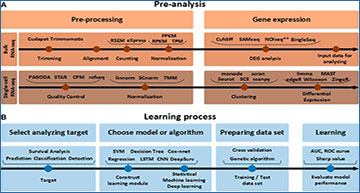The incidence and mortality rates of lung cancer are high worldwide, where non-small cell lung cancer (NSCLC) accounts for more than 85% of lung cancer cases. Recent non-small cell lung cancer research has been focused on analyzing patient prognosis after surgery and identifying mechanisms in connection with clinical cohort and ribonucleic acid (RNA) sequencing data, including single-cell ribonucleic acid (scRNA) sequencing data. Researchers from Yonsei University investigate statistical techniques and artificial intelligence (AI) based non-small cell lung cancer transcriptome data analysis methods divided into target and analysis technology groups. The methodologies of transcriptome data were schematically categorized so researchers can easily match analysis methods according to their goals. The most widely known and frequently utilized transcriptome analysis goal is to find essential biomarkers and classify carcinomas and cluster NSCLC subtypes. Transcriptome analysis methods are divided into three major categories: Statistical analysis, machine learning, and deep learning. Specific models and ensemble techniques typically used in NSCLC analysis are summarized in this paper, with the intent to lay a foundation for advanced research by converging and linking the various analysis methods available.
RNA-seq workflow of how to preprocess data and conduct analysis
The preprocessing section is divided into bulk RNA-seq and single-cell RNA-seq, where each require quality control. In addition, differential gene expressions are derived to obtain data for analysis. In the Analysis section, the target is classified into Predictive Biomarker, Prognostic Biomarker, and Cancer Classification, and analysis methods are sub-classified according to each purpose. In addition, the necessary tools according to the data type are indicated in green for Statistical Analysis, orange for the Machine Learning techniques, and blue for the me`thods using Deep Learning.
Joo MS, Pyo KH, Chung JM, Cho, BC. (2023) Artificial intelligence-based non-small cell lung cancer transcriptome RNA-sequence analysis technology selection guide. Front Bioeng Biotechnol [Epub haead of print]. [article]





